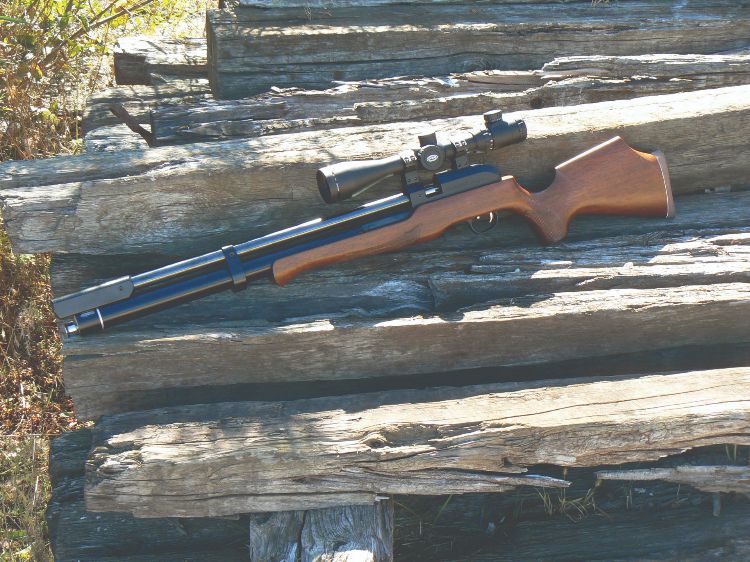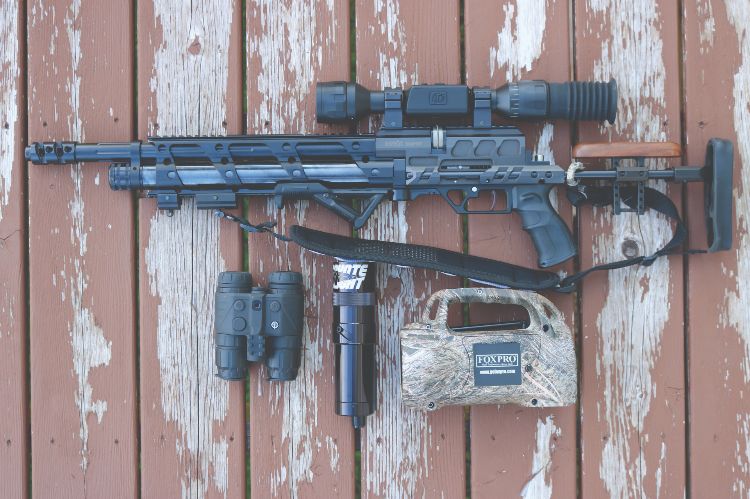Whilst driving to one of the huge ‘destination’ sporting-goods stores, a couple hours south of where I live, I used the drive time to recall past airgun hunting adventures. To be honest, it was not just a trip down memory lane, but I also wanted to come up with a fresh idea for this article. After arriving at the store, I gravitated toward the gun counter – funny how that happens – where I overheard a couple guys arguing the merits of their predator rifles. One seemed convinced that an AR platform was the only way to go, whilst his buddy was turning a Remington 700 over in his hands, obviously a fan of the traditional design.
This debate didn’t surprise me. Looking back at some of the mail I’ve received, a recurring question asks whether I prefer tactical air rifle designs, or more traditional sporter configurations for my hunting guns. This is a topic with several moving parts that include one’s personal preferences and experience, societal views on the designs, and the features and benefits of each and how they fit individual intended use.
Traditional sporter-style rimfire and centrefire rifles were my gateway into hunting, and that formed my view of what a rifle should look and feel like. I used single-action, bolt-action, lever-action, pump-action, and semi-automatic versions of these rifles; I appreciated the look and feel of wooden stocks, and later laminates and synthetics – and the sporter design just seemed right to me.
 Traditional hunting rifles
Traditional hunting rifles
‘Sporter’ or ‘traditional design’ is a somewhat nebulous term, but for the purpose of this article let’s just say it’s a combination of the stock configuration and general features. The fore stock supports the receiver, and provides a convenient handhold. The butt stock is braced against the shooter's shoulder for stability, and interacts with the trigger hand. In the traditionally-stocked rifles, the length of pull can be adjusted by replacing the butt pad with one of different dimensions and the comb (or cheekpiece) might be adjustable, but in many sporter styles, is not.
There are various grip configurations used on the traditional hunting rifle. A straight grip proceeds smoothly from toe to the trigger, providing a more horizontal holding angle for the trigger hand. The best example I have is on my Beeman CI springer, and I absolutely love this stock. As a matter of fact, I have had it replicated for a couple of my PCP rifles, as well. I find it very fast to deploy, whilst providing a consistent hold on the rifle. Many shooters dislike the straight grip as much as I like it, and it is not prevalent on today’s rifles. The most common grip configuration on traditional sporter stocks is the semi-grip, which has a steeper angle cut into the stock to provide a more diagonal angle for the trigger hand. This grip is quite ergonomic and seems to fit the widest range of shooters and conditions.
So, we end up with a fairly broad definition of the ‘traditional’ hunting rifle; it can use a variety of actions, the furniture might be wood, laminate, or synthetic, and it can be a one- or two-piece configuration. The overall dimensions of these rifles are often sleek, with chequering or stippling on the grip and fore stock; they tend to be well balanced and carry naturally on a sling, and to my eye, they can be a thing of beauty. I find heading into the field with a well-made traditional hunting rifle slung over my shoulder one of the greatest of outdoor pleasures!
 Tactical rifle designs
Tactical rifle designs
A few years back, we started to see the airgun manufacturers following the same trends noted in the firearms world – namely, the addition of more tactical designs to their product lines. As with firearms, these came in two primary flavours; the tactical or ‘black’ rifle designs, and bullpups, the latter arguably leading the way with the number of new models being introduced. Initially, I was not impressed. I’d carried an AR-15 whilst in the Army, and although I shot it well enough, I never considered the ergonomics especially noteworthy. To be fair, though, most of my practical experience was either on the range or slung on my back for training exercises. I had very little exposure to bullpups at that time, but didn’t really give them much thought for inclusion in my hunting kit.
So, as I organically built up my air rifle collection, almost all the guns I acquired were traditional designs. As my media exposure grew – and that’s a weird story in its own right – manufacturers started offering to send me rifles for testing. To start with, I only requested samples of their traditional sporting guns – I was more than content stalking my hunting grounds with an Air Arms S410 or a Daystate Huntsman slung on my shoulder, and these epitomised my taste in hunting rifles!
Eventually, I gave in to repeated requests to use and review the tactical models and bullpups and my first impression of these guns was somewhat ambivalent. I found that the tactical and bullpup guns tended to be bulkier, many were heavier than my traditional rifles, and the aesthetics did not grab me, but I had to admit that the performance was often very good, and many of the guns could be adjusted to fit me and optimise the overall ergonomics.
Bottle for a butt stock
One of the first ‘tactical – look’ rifles I tried was the Logun S-16 PCP, a 16-shot rifle in .22 calibre with a pistol grip, a 16” shrouded barrel, and the first ‘bottle for a butt stock’ design I’d encountered. The performance of this rifle was good, but even though it was fairly compact, the stock was fixed and not adjustable, and I never felt really comfortable or dialled in with it.
Next, I started shooting the AirForce Condor, which is a fine single-shot gun with the tactical look. Like the Logan, it featured a ‘bottle for a butt stock’ design, and a pistol grip. The butt stock isn’t the most ergonomic, but it is functional and there is some latitude for adjusting the shoulder plate, fore stock, and rails for mounting accessories, and there are many aftermarket parts and kits that allow it to be further optimised for the individual shooter. This gun is compact, lightweight, accurate, and one I really like to carry. AirForce has also built an extremely powerful big bore that takes many design cues from the standard Condor/Talon models.
A rifle with a ‘military’ design that I’ve been shooting and hunting with more recently, is the Hatsan Invader. My rifle is the high-power .25 calibre version, and what sets this gun apart is that it features a semi-automatic action. This is a full-sized rifle, dressed in a synthetic thumbhole stock with an integrated pistol grip, a removable carry handle/sighting system, adjustable cheekpiece, and removable air cylinder.
Bullpup development
Arguably, the design that has seen the most development is the bullpup. I’ve covered this topic in a separate article, so I won’t do a deep dive here, but in general, these guns are compact, ergonomic, offer performance on a par with full-sized gun, are easy to carry, and I shoot many of them particularly well offhand. The design tends to pull the guns weight into the shooter’s centre of gravity, offering a stable hold.
Some of the newer bullpup designs, such as the FX Maverick, are technically bullpups, but I believe feel more like a carbine on the shoulder. The Maverick features a ‘bottle for a fore stock’ design that permits an adjustable butt stock to be incorporated, along with an AR compatible pistol grip, and is an example of a highly adjustable hunting rig, both physically and in respect to ballistics.
Closing thoughts on tactical vs Traditional
The term ‘tactical’ in regard to air rifles is merely a convenient way of grouping some features, characteristics, or cosmetic attributes of the rifles. I use the term to describe a gun that has a pistol grip, usually a synthetic stock, often incorporating a carry handle, rails for mounting accessories, a short barrel – or in the case of the bullpup a short LOA, and may have a folding or telescoping stock. As a matter of fact, some of these guns use components standardised for an AR platform. Obviously, there is really no such thing as a tactical airgun, but at some venues, this cosmetic element may be a deterrent for using the design.
Circling back to the question of my preference – a tactical design, or a traditional design for my hunting rigs? Well, it depends on what I’m going to do with it. I still think the traditional sporter style has a much more refined appearance and a better feel on the shoulder, which I prefer on an aesthetic basis. I still think my Daystate Huntsman is one of the most beautiful hunting rifles ever built, and for a day of strolling through the woods on a squirrel hunt, when I’ll walk a couple of miles and take a dozen offhand shots, I can’t think of a better gun to use.
On the other hand, if heading out for a day of long-distance prairie dog shooting, when I will be mounting the gun on a tripod and shooting rested, give me that Maverick! Or if varmint hunting at night, when I need to mount lights or a laser, one of the tactical designs like the Hatsan Invader will probably work better for me.
Whilst I will admit the cosmetic appearance of the tactical guns and bullpups do not strike the same chord as a traditional rifle for me, I do appreciate the form-follows-function beauty of these designs. If I were limited to one rifle, my preference would be a modular tactical design like the Maverick, that would allow easy swapping of barrels and calibres, adjustable power, and be compact for both transporting and carrying in the field, but this is a utilitarian choice based on my pattern of use. If I could have multiple guns including both tactical and traditional styles, and you asked me which design was my favourite, I’d probably pull out the Huntsman!